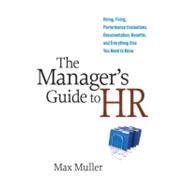
What is included with this book?
Max Muller (Overland Park, KS), an attorney, began his involvement in human resources law in 1976 when he became house counsel for Isis Foods. He has presented thousands of seminars on the topic of human resources, including many for the American Management Association.
| Hiring | p. 1 |
| Defining the Job | |
| Writing the Job Description | |
| Recruiting | |
| Interviewing | |
| Verifying Employment Eligibility | |
| Performance Evaluations | p. 35 |
| The Job Description | |
| Employee Self-Review | |
| Structured Performance Reviews and Discrimination | |
| Training | p. 41 |
| Strategy | |
| Safety | |
| Sexual Harassment | |
| Training | |
| Records | |
| Benefits | p. 51 |
| The Family and Medical Leave Act | |
| Covered Entities | |
| The Twelve-Month Period | |
| Notice | |
| Scheduling the Leave | |
| The Workweek | |
| Employee Eligibility | |
| Eligible Reasons for Leave | |
| Unpaid Nature of Leave | |
| Maintaining Health Benefits | |
| Serious Health Conditions | |
| Health-Care Provider | |
| Key Employees | |
| Consolidated Omnibus Budget Reconciliation Act of 1985 | |
| Health Insurance Portability and Accountability Act of 1996 - Preexisting Conditions | |
| Compensation: The Fair Labor Standards Act | p. 87 |
| Minimum Wage and Overtime | |
| Compensable Hours | |
| Equal Pay for Men and Women (Equal Pay Act) | |
| Child Labor | |
| Coverage | |
| Benefits and Payroll Practices Not Covered by the FLSA | |
| Exempt vs. Nonexempt Status Under the FLSA | |
| Wage and Hour Violations | |
| Employment Laws | p. 117 |
| Key Federal Employment Laws | |
| Prohibited Acts | |
| Enforcement Mechanisms | |
| Proof of Discrimination | |
| Title VII Remedies | |
| Federally Protected Classes | |
| State and Local Protected Classes | |
| Hot-Button Issues: Sexual Harassment and Workplace Violence | p. 165 |
| Sexual Harassment Defined | |
| The Ellerth/Faragher Defense | |
| The Investigation | |
| Workplace Violence | |
| Privacy Issues | p. 201 |
| Background Checks | |
| Medical Information During the Hiring Process | |
| Monitoring Employees in the Workplace | |
| Invasion of Privacy | |
| Defamation, Libel, and Slander | |
| Intentional Infliction of Emotional Distress or Outrage | |
| False Imprisonment | |
| Firing and Separation | p. 231 |
| Policy Statements May Alter At-Will Employment | |
| How to Reestablish the At-Will Privilege | |
| Progressive Discipline | |
| The Termination Session | |
| Wrongful Discharge | |
| The Worker Adjustment and Retraining Notification Act | |
| Documentation and Records Retention | p. 247 |
| Personnel Records in General | |
| Medical Information | |
| Other Documents That Should Not Be Kept in a Personnel File | |
| EEOC Minimum Document Retention Rules Under Title VII | |
| Document Retention Policies | |
| OSHA Record Keeping | |
| Index | p. 287 |
| Table of Contents provided by Blackwell. All Rights Reserved. |
The New copy of this book will include any supplemental materials advertised. Please check the title of the book to determine if it should include any access cards, study guides, lab manuals, CDs, etc.
The Used, Rental and eBook copies of this book are not guaranteed to include any supplemental materials. Typically, only the book itself is included. This is true even if the title states it includes any access cards, study guides, lab manuals, CDs, etc.